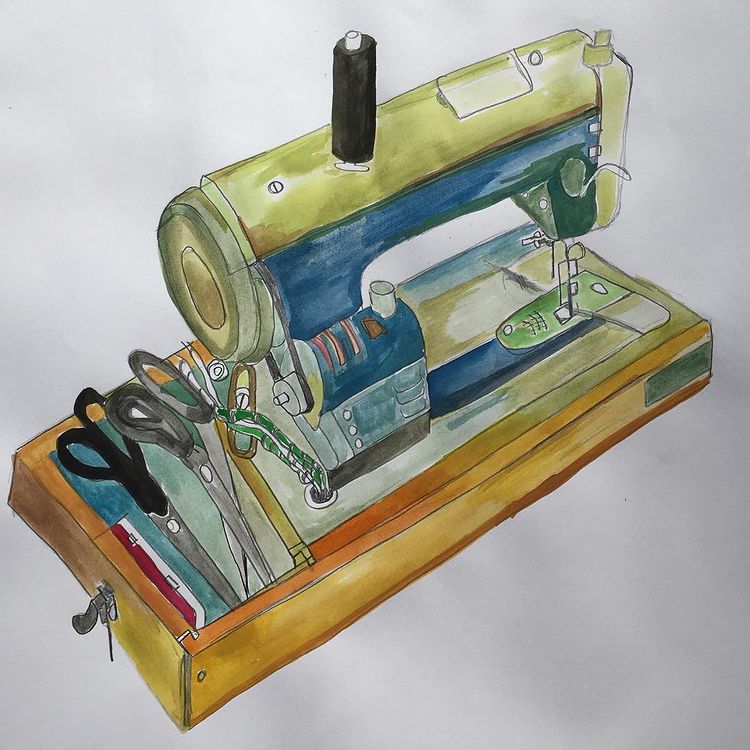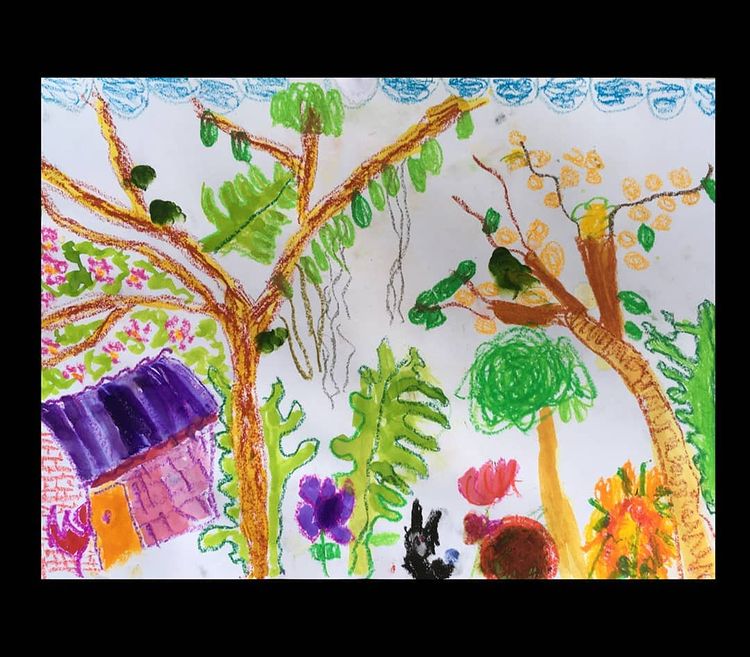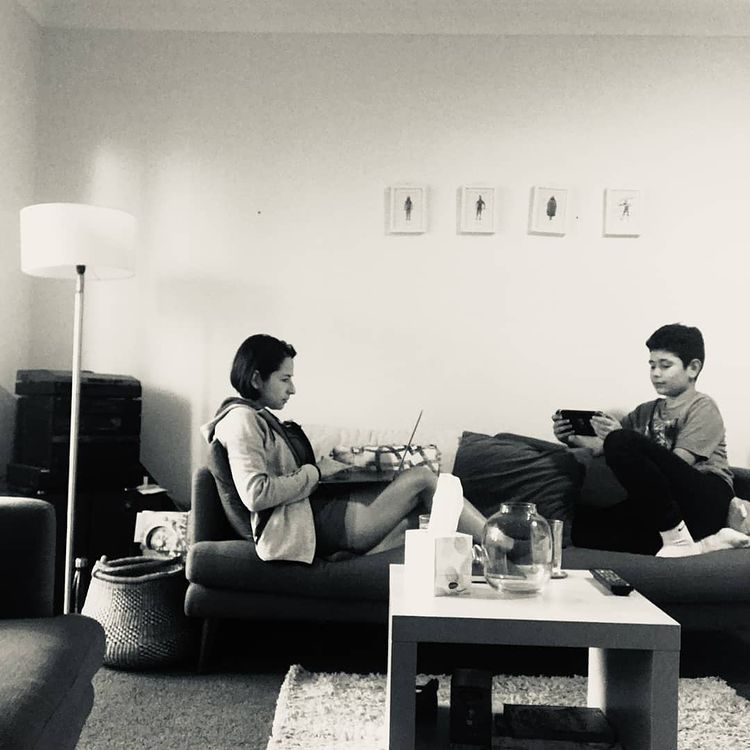Covid-19 isolation prompted a popular Instagram project that brought people’s imaginative life and home life together in art and spawned This Time 2020, the Orchard Gallery’s current exhibition in Waterloo. In this Q&A, curator Catherine Skipper reveals how the project evolved and offers insights into what’s on show.
How long had you been artist-in-residence at the Orchard Gallery (South Sydney Uniting Church) when Covid-19 and its requirement to isolate hit Sydney?
I think for a year, which had already been very much interrupted by exigencies such as a broken rib and deteriorating eyesight. Eye surgery on my right eye was a success but as I yet await surgery to the left eye focussing is problematical … very problematical when the medium you chose to explore is etching. I was grateful to Andrew Collis (South Sydney Uniting Church [SSUC] minister and enabler of creative impulses) and the Church Council for always being supportive through the various interruptions to sustained effort.
How did this restriction affect your placement, and what did it feel like?
I was in the process of learning and I had relied upon the kindness and skill of teachers – Micaela Christie at the Pine Street Arts Centre and then Seraphina Martin at the School of Fine Art (SOFA) to expand my knowledge of printing techniques in general – etching, linocut, collography and wood block – and to refine my chosen technique, etching into aluminium.
As the courses were cancelled owing to Covid-19 I felt at a loss, as attending the courses had given me a structure and I had enjoyed the camaraderie felt between people working together with a common interest. Great energy is generated through a group pursuit and carries over through the week until the next meeting. I was so grateful that SOFA decided to reinstitute its course for the fourth term of 2020.
Whose idea was it to invite people to take isolation as a time to become reacquainted with their homes and gardens, and to send their works in to be published on the Orchard Gallery’s Instagram feed?
The idea came from me and was enthusiastically supported by Andrew. I was used to going to classes, including the bimonthly art class held at the SSUC, and benefitted from the interaction and connection – as did we all – and I thought that there could still be interaction, although of a different sort and more far-reaching perhaps. And so it turned out, through posting on Instagram.
When the artists sent in their work via email they would usually say why this aspect of their habitat had become more important to them and often followers of the Orchard would react through the comment button. There was also the pleasure of looking forward to a new post each day and the surprise of who it might be and what they had discovered about their domestic world.
Eventually, after becoming a participant in a drawing class on Zoom with Kristin Coburn of SOFA – and absolutely loving it, thriving on it – I realised we could hold our twice monthly art classes on Zoom which further provided contributions to This Time from artists.
Did you expect such a strong response?
I was more hopeful that the project could offer interaction and connection than having expectations about the response. It was a pleasure to see how generously artists took up the theme beginning with home (often the sofa) passing on to the garden, which included views from the nature strip. We all loved the lively and varied art and craft work sent in by children and could see how the theme fitted in with children having to do lessons from home, or artists having more time to spend with their young.
Who else apart from art group artists participated?
Neighbours of SSUC, tenants from Waterloo estate, members of the SSUC congregation, members from the local community and from Counterpoint, and followers of the Orchard Gallery Instagram feed.
In curating This Time for the Orchard Gallery (December 19 to January 8) you chose many works from the Instagram feed but also picked other works with a domestic focus that didn’t feature on the feed. What was your main focus as curator?
Including other works with a domestic focus maybe illustrates the success of the Instagram project as the impulse to record our personal environment and our inner connection with it carried on after the project closed. Often our inner connection can be referential as with perhaps the unexpected inclusion of Margaret Vazey’s lovely portrait of a beautifully contented echidna, reflective and good-humoured, looking over its folded arms. Marg has incorporated the word “wombat” into her Instagram account name, and echidnas, as we know, often make their home in wombat burrows, and so it seemed that this echidna was lodging so very comfortably in Marg’s imaginative life.
So, it’s possible that my focus for selection was how the idea of home lodges itself in our inner life and then how we translate that into the outer world. If art is healing it is for this reason – it is unifying, bringing our inner experience into the experiential world in a single “take” – although it may be very complex in itself and without resolution. There is struggle, many decisions and revisions, a risk – and commitment to action even if it is just pressing a button to alter the colour – and in the interstices creativity gets the opportunity to drop in on you.
Kafka’s statement on the room sheet that “isolation is a way to know ourselves” is a signpost. It is a way to know ourselves and, in this case, to explore how we have constructed our own habitat, the choices we have made in the process – for instance, why a sofa in the kitchen (Hayley Megan French – and how inviting it looks) – and why we made those choices. It is also a way to know beyond ourselves as we may start with the image of sewing machine (Alana Valentine’s “Homemade”), an image of how we sew the bits and pieces of our individual or collective experience to give it a coherent shape and a new way of being understood. It’s also about memories – what we keep and why.

Your commentary about the works that accompanied the Instagram posts was insightful and warming. Could you offer our readers some insights into two or three of the works in the show?
I love the spontaneity and vigour of Gracie’s painting and its brilliant colours and that way of seeing everything at once on the same plane – feeling the vitality and freshness of the garden and the pleasure of a child to whom everything is new.
There were several images of the sofa – it almost might seem that the sofa was the heart of the household. It offers solace, the opportunity to unwind, a refuge from the pressures of life and a shared space. Estrella Sandoval’s enchanting black and white photograph encapsulates the sofa, an island in the sea of unruly life, shared in this case, by mother and son, each busy with their own agenda but comfortable in their domestic pod.

I was amazed at how eagerly people shared their private spaces and objects – with jugs, cups, sofas, pets, and plants featured. How much guidance was given about what to draw when, and to what do you attribute the artists’ openness?
The guidance was minimal. The government’s advice to stay home as much as possible, children schooling from home, people working from home – offered an opportunity to re-connect with our personal habitat, reassess what we valued about it, explore it and think about it as a habitat we had created by making certain choices. I’d say Hayley Megan French’s “Sofa days” and my “Lambert at the window” are rich examples of human habitats.
I think perhaps the proposed demolition of Waterloo Estate had intensified my feelings about the importance of home – home is place important to our sense of identity and the need to feel we belong, fit in somewhere that is our own particular space – and the government’s casual assumption that their home was of no special significance to people living in public housing and that they could be “relocated” came as a shock to me.

You said that in isolation you really enjoyed drawing in black ink with a nib pen and also with a brush, and your drawing improved. Did you notice changes in the work of other artists?
I did notice that some artists became more interested in drawing or painting in ink, maybe familiarity with their subject enabled them to reduce it to line or form whether it’s a pair of spectacles with a mug, a cliff face, a little black bunny or a little white dog. It fits with observation, recording. Photography was popular given that it “captures” a scene or a moment, an action or an object, that it can be a quick response to changes in light – and shade – and that it can be enhanced or altered by various apps when there is time to be playful or experimental.
If we take Alana Valentine’s three works as an example, we see she’s working across three areas, watercolour, collage and fabric printing – I don’t think she would normally have the time to do this. Her watercolour “Homemade” was greatly loved, a simple object on white paper but invested with the warmth she felt for a valued partner in creativity.
An ink drawing of yours in This Time called “Kitchen triumvirate” makes the solid objects seem almost molten or like rotting fruit – an amazing representation and transformation. What did you feel when you were creating this piece and what was the process like?
Three very familiar objects, the lynchpins of my daily life: ceramic, organic, metallic … and what I was thinking was “What am I thinking?” I call the process “Following my brush”. My brush is special, it’s French and many years old, and getting thinner and thinner, but it knows a great deal more than I do. Afterwards, I thought it might be about the struggle to hold a shape, usefulness, a place and the knowledge of dissolution.
Just as This Time opened, Covid-19 restrictions across Sydney were being reintroduced and therefore fewer people than anticipated will get to see it. How disappointing is this?
It’s not disappointing at all. It’s always just doing it that matters, gathering, forging into a new creation that didn’t exist before, making a room sheet … it’s giving an idea an airing in the real world … declaring the value of imagination, intuition and creativity … of art and the arts … and it’s great to be able to have an opening when people can come together, circulate carrying their room sheet, ask questions, talk about the works, and choose one they like in particular, but they can’t and so “This Time” becomes “That Time” when things were different.
_______________
This Time 2020 is at the Orchard Gallery from December 17, 2020 to January 31, 2021.
@orchardgalleryau





